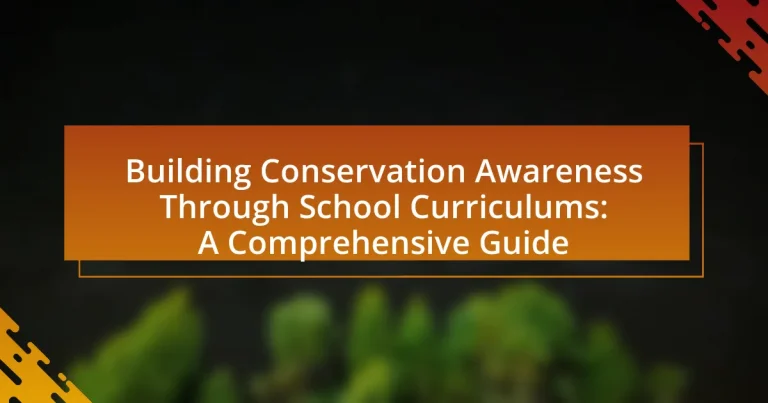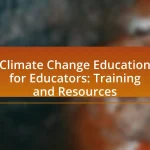Building conservation awareness through school curriculums involves integrating heritage preservation and environmental sustainability into educational programs. This approach educates students on the significance of conserving historical buildings and natural resources, fostering a sense of responsibility towards cultural heritage. The article outlines the importance of conservation awareness in education, its impact on student behavior, and the key components of a conservation-focused curriculum. It also discusses effective subjects for integration, hands-on learning activities, and strategies for schools to implement conservation programs. Additionally, the article addresses challenges faced in building conservation awareness and highlights the benefits of community involvement and innovative teaching methods in enhancing conservation education.
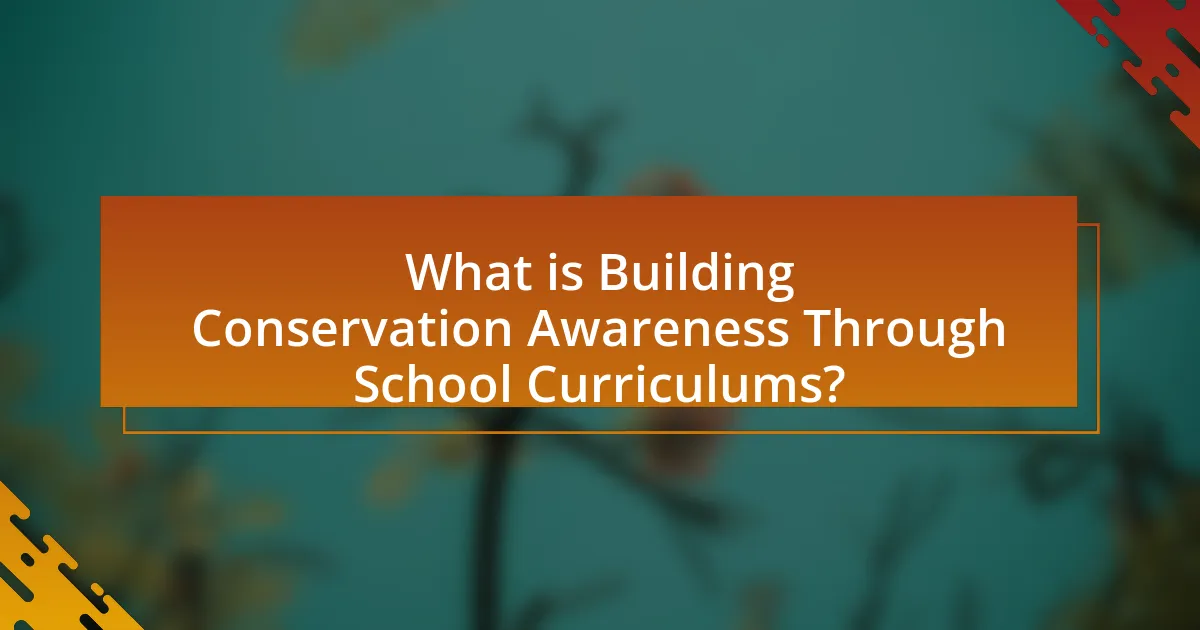
What is Building Conservation Awareness Through School Curriculums?
Building conservation awareness through school curriculums involves integrating principles of heritage preservation and environmental sustainability into educational programs. This approach aims to educate students about the importance of conserving historical buildings and natural resources, fostering a sense of responsibility towards cultural heritage. Research indicates that when students engage with conservation topics in their studies, they develop a greater appreciation for their local history and environment, which can lead to increased community involvement in preservation efforts. For instance, programs that include field trips to historical sites or projects that involve local conservation initiatives have shown to enhance students’ understanding and commitment to conservation practices.
Why is conservation awareness important in education?
Conservation awareness is important in education because it fosters environmental stewardship among students. By integrating conservation topics into school curriculums, educators equip students with knowledge about ecological systems, biodiversity, and sustainable practices. Research indicates that early exposure to conservation concepts leads to increased pro-environmental behaviors; for instance, a study published in the Journal of Environmental Education found that students who participated in conservation-focused programs demonstrated a 30% increase in environmentally responsible actions compared to those who did not. This highlights the critical role of education in shaping future generations’ attitudes and actions towards the environment.
How does conservation awareness impact student behavior?
Conservation awareness significantly influences student behavior by fostering environmentally responsible actions and attitudes. When students are educated about conservation, they are more likely to engage in practices such as recycling, reducing waste, and conserving energy. Research conducted by the National Wildlife Federation indicates that students who participate in conservation education programs demonstrate a 30% increase in pro-environmental behaviors compared to those who do not receive such education. This correlation highlights the effectiveness of integrating conservation awareness into school curriculums, ultimately leading to a generation that prioritizes sustainability and environmental stewardship.
What role does education play in fostering environmental stewardship?
Education plays a crucial role in fostering environmental stewardship by equipping individuals with the knowledge and skills necessary to understand and address environmental issues. Through structured curricula, students learn about ecosystems, sustainability, and the impact of human activities on the environment, which cultivates a sense of responsibility towards nature. Research indicates that educational programs focused on environmental science can significantly increase students’ awareness and engagement in conservation efforts, as evidenced by a study published in the Journal of Environmental Education, which found that students who participated in environmental education programs demonstrated a 50% increase in pro-environmental behaviors compared to those who did not. This highlights the effectiveness of education in promoting active participation in environmental stewardship.
What are the key components of a conservation-focused curriculum?
A conservation-focused curriculum includes key components such as environmental education, hands-on experiences, interdisciplinary approaches, community involvement, and critical thinking skills. Environmental education provides foundational knowledge about ecosystems, biodiversity, and sustainability practices. Hands-on experiences, like field trips and projects, engage students in real-world conservation efforts. Interdisciplinary approaches integrate subjects like science, geography, and social studies to foster a holistic understanding of conservation issues. Community involvement encourages partnerships with local organizations to enhance learning and promote stewardship. Finally, critical thinking skills empower students to analyze environmental challenges and develop innovative solutions. These components collectively aim to cultivate a generation that values and actively participates in conservation efforts.
What subjects can integrate conservation themes effectively?
Subjects that can integrate conservation themes effectively include science, geography, social studies, and art. Science education can address ecological principles, biodiversity, and environmental science, fostering an understanding of ecosystems and conservation methods. Geography can explore human-environment interactions, land use, and the impact of climate change, emphasizing the importance of sustainable practices. Social studies can incorporate discussions on environmental policies, ethics, and the role of communities in conservation efforts. Art can be utilized to express environmental issues and promote awareness through creative projects, encouraging students to engage with conservation themes visually and emotionally.
How can hands-on activities enhance conservation learning?
Hands-on activities enhance conservation learning by providing experiential opportunities that engage students directly with environmental concepts. These activities, such as field trips, habitat restoration projects, and interactive workshops, allow learners to observe and participate in conservation efforts, fostering a deeper understanding of ecological systems. Research indicates that experiential learning increases retention of information; for instance, a study by the National Science Foundation found that students who participated in hands-on science activities scored 20% higher on assessments compared to those who learned through traditional methods. This active involvement not only cultivates critical thinking and problem-solving skills but also instills a sense of responsibility towards environmental stewardship.
How can schools implement conservation awareness programs?
Schools can implement conservation awareness programs by integrating environmental education into their curricula and engaging students in hands-on conservation projects. This approach not only educates students about ecological issues but also fosters a sense of responsibility towards the environment. For instance, studies show that schools that incorporate outdoor learning experiences, such as field trips to nature reserves or local clean-up events, significantly enhance students’ understanding of conservation principles. Additionally, collaboration with local environmental organizations can provide resources and expertise, further enriching the educational experience.
What strategies can educators use to engage students in conservation?
Educators can engage students in conservation by incorporating hands-on activities, such as field trips to natural reserves, which provide real-world experiences that enhance understanding of ecological systems. Research indicates that experiential learning significantly increases student interest and retention of conservation concepts. For instance, a study published in the Journal of Environmental Education found that students who participated in outdoor learning experiences demonstrated a 70% increase in knowledge retention compared to traditional classroom settings. Additionally, integrating technology, such as virtual reality simulations of ecosystems, can further captivate students’ attention and foster a deeper connection to conservation issues.
How can partnerships with local organizations support conservation education?
Partnerships with local organizations can significantly enhance conservation education by providing resources, expertise, and community engagement opportunities. Local organizations often possess specialized knowledge about regional ecosystems and conservation challenges, which can be integrated into educational programs. For example, a study by the National Wildlife Federation found that schools collaborating with local environmental groups reported a 30% increase in student engagement in conservation topics. Additionally, these partnerships can facilitate hands-on learning experiences, such as field trips and community projects, which reinforce classroom learning and foster a sense of stewardship among students.
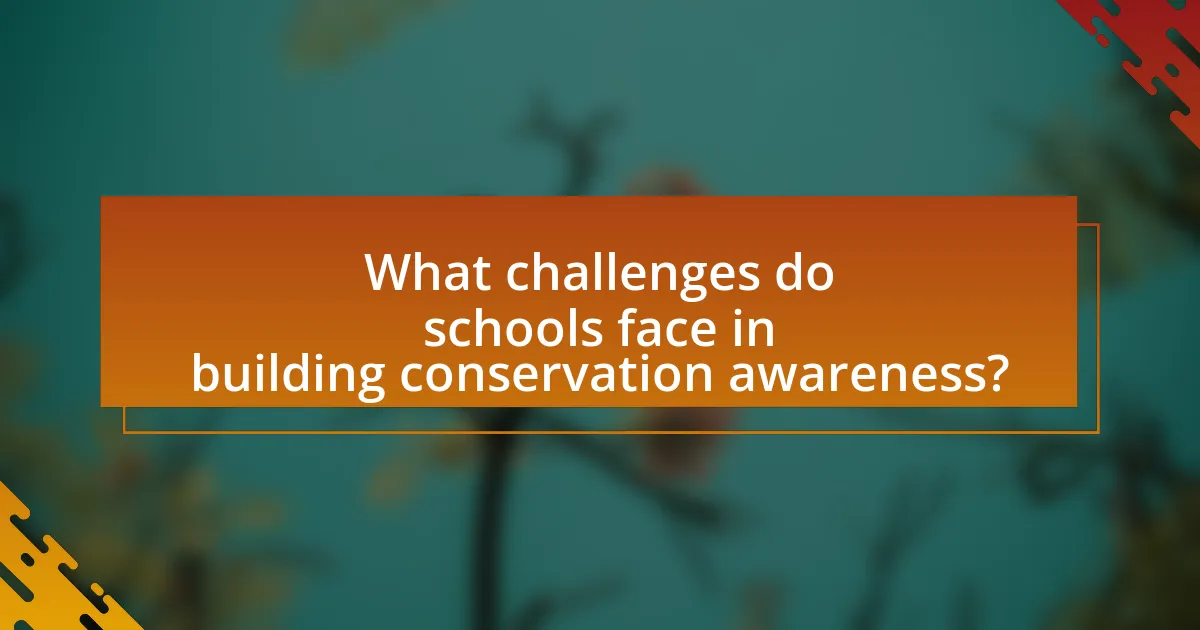
What challenges do schools face in building conservation awareness?
Schools face several challenges in building conservation awareness, including limited resources, lack of trained educators, and insufficient integration of conservation topics into existing curricula. Limited funding often restricts access to educational materials and field trips that could enhance learning experiences related to conservation. Additionally, many educators may not have the necessary training or background in environmental science, which can hinder effective teaching. Furthermore, conservation topics are frequently not prioritized within the curriculum, leading to a lack of comprehensive education on environmental issues. These challenges collectively impede the development of a robust conservation awareness among students.
What are common barriers to implementing conservation curriculums?
Common barriers to implementing conservation curriculums include lack of funding, insufficient teacher training, and limited resources. Funding constraints often hinder the development and maintenance of effective programs, as schools may prioritize other areas over conservation education. Additionally, teachers may not receive adequate training in environmental topics, leading to a lack of confidence in delivering the curriculum. Limited access to educational materials and resources further complicates the implementation process, as schools may struggle to find appropriate tools to engage students in conservation efforts.
How can funding limitations affect conservation education initiatives?
Funding limitations can significantly hinder conservation education initiatives by restricting resources necessary for effective program implementation. When financial support is inadequate, schools may lack access to essential materials, such as educational tools, field trips, and expert guest speakers, which are crucial for engaging students in conservation topics. For instance, a study by the National Science Foundation found that schools with limited budgets often struggle to incorporate hands-on learning experiences, which are vital for fostering a deep understanding of environmental issues. Consequently, this lack of funding can lead to reduced program quality, lower student participation, and ultimately, diminished awareness and advocacy for conservation efforts among future generations.
What resistance might educators encounter when introducing conservation topics?
Educators might encounter resistance from parents and community members when introducing conservation topics. This resistance often stems from differing beliefs about environmental issues, perceived political implications, or concerns over curriculum content. For instance, a survey by the National Education Association found that 60% of teachers reported facing pushback from parents regarding environmental education, indicating a significant level of resistance. Additionally, some educators may face administrative challenges, such as lack of support or resources to effectively teach conservation topics, further complicating their efforts to integrate these subjects into the curriculum.
How can schools overcome these challenges?
Schools can overcome challenges in building conservation awareness by integrating environmental education into their curriculums. This approach ensures that students learn about conservation principles and practices from an early age, fostering a culture of sustainability. Research indicates that schools implementing comprehensive environmental education programs see increased student engagement and awareness; for instance, a study by the National Environmental Education Foundation found that 83% of teachers reported improved student understanding of environmental issues after integrating such programs. Additionally, collaboration with local environmental organizations can provide resources and expertise, enhancing the educational experience and reinforcing the importance of conservation in the community.
What resources are available to support conservation education?
Resources available to support conservation education include educational programs, online platforms, and community initiatives. Educational programs such as Project Learning Tree and the National Wildlife Federation’s Eco-Schools provide structured curricula that integrate conservation topics into school lessons. Online platforms like the Environmental Protection Agency’s (EPA) website offer a wealth of resources, including lesson plans and interactive tools for teachers. Community initiatives, such as local conservation groups and nature centers, often provide hands-on learning experiences and workshops that engage students in conservation efforts. These resources collectively enhance awareness and understanding of conservation issues among students.
How can community involvement enhance conservation efforts in schools?
Community involvement enhances conservation efforts in schools by fostering collaboration between students, educators, and local organizations. This collaboration leads to increased resources, such as funding and expertise, which can be utilized for conservation projects. For instance, partnerships with environmental groups can provide hands-on learning experiences, such as field trips and workshops, that deepen students’ understanding of ecological issues. Research indicates that schools with active community engagement in environmental initiatives report higher student participation and improved conservation outcomes, as seen in programs like the Eco-Schools initiative, which has successfully integrated community resources into school curriculums globally.
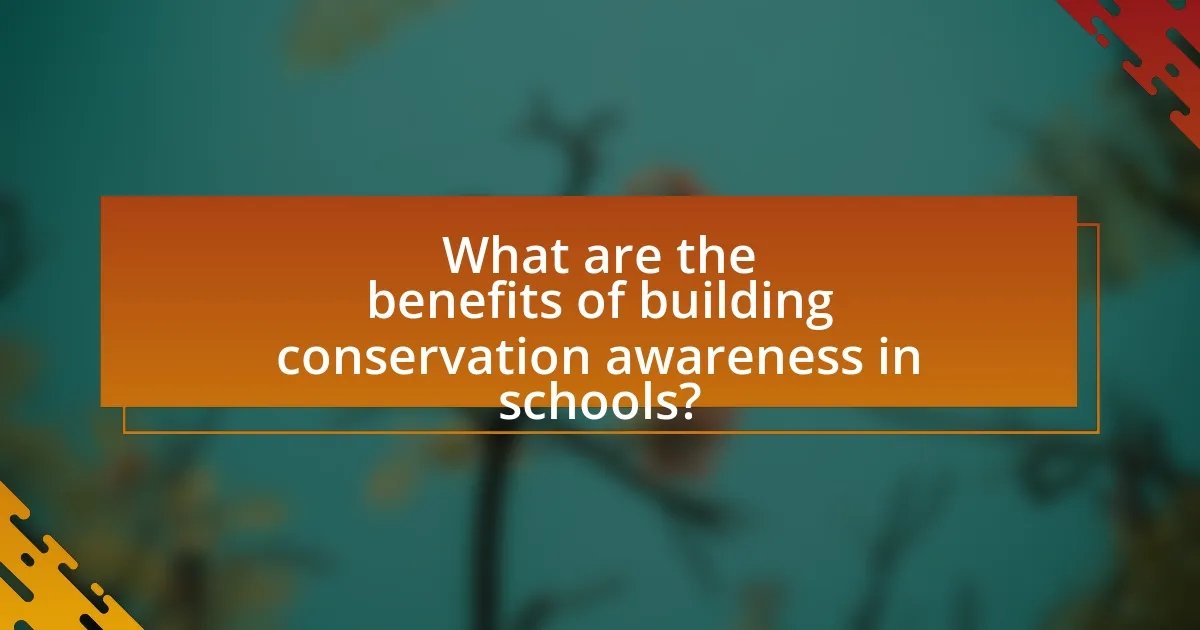
What are the benefits of building conservation awareness in schools?
Building conservation awareness in schools fosters environmental stewardship among students. This awareness leads to increased knowledge about ecological issues, promoting responsible behaviors such as recycling and energy conservation. Research indicates that students exposed to conservation education are more likely to engage in sustainable practices, as evidenced by a study published in the Journal of Environmental Education, which found that 75% of students who participated in conservation programs reported changing their habits positively. Additionally, building this awareness can enhance critical thinking and problem-solving skills, as students learn to analyze environmental challenges and develop solutions.
How does conservation education influence student outcomes?
Conservation education significantly enhances student outcomes by fostering environmental awareness and promoting sustainable behaviors. Research indicates that students exposed to conservation education demonstrate improved knowledge of ecological principles, increased engagement in environmental stewardship, and a greater likelihood of participating in conservation activities. For instance, a study published in the Journal of Environmental Education found that students who participated in conservation programs showed a 30% increase in their understanding of biodiversity and ecosystem services compared to those who did not receive such education. This evidence underscores the positive impact of conservation education on shaping informed and responsible future citizens.
What skills do students develop through conservation-focused learning?
Students develop critical thinking, problem-solving, teamwork, and communication skills through conservation-focused learning. These skills are cultivated as students engage in hands-on projects, analyze environmental issues, and collaborate with peers to propose solutions. For instance, a study by the National Environmental Education Foundation found that students involved in conservation projects demonstrated enhanced analytical abilities and improved collaboration skills, as they worked together to address real-world environmental challenges.
How does conservation awareness contribute to a sustainable future?
Conservation awareness significantly contributes to a sustainable future by fostering a collective understanding of environmental issues and promoting responsible resource management. When individuals are educated about the importance of biodiversity, ecosystem health, and sustainable practices, they are more likely to engage in behaviors that protect natural resources. For instance, studies show that communities with higher levels of conservation awareness tend to implement more effective recycling programs and conservation initiatives, leading to reduced waste and lower carbon footprints. This correlation is supported by research from the World Wildlife Fund, which indicates that increased public awareness can lead to a 20% reduction in resource consumption in communities actively engaged in conservation efforts.
What impact does conservation awareness have on the community?
Conservation awareness significantly enhances community engagement and environmental stewardship. When communities are educated about conservation, they tend to participate more actively in local environmental initiatives, leading to improved biodiversity and sustainable practices. For instance, a study by the National Oceanic and Atmospheric Administration found that communities with strong conservation education programs reported a 30% increase in volunteer participation for local conservation projects. This heightened involvement fosters a sense of responsibility and collective action, ultimately benefiting both the environment and the community’s quality of life.
How can students become advocates for conservation in their neighborhoods?
Students can become advocates for conservation in their neighborhoods by engaging in community projects, educating peers and residents about environmental issues, and participating in local conservation initiatives. For instance, students can organize clean-up events in parks or along waterways, which not only improves local habitats but also raises awareness about pollution. Research shows that youth-led initiatives can significantly increase community participation in conservation efforts, as demonstrated by the “Youth in Action” program, which reported a 40% increase in local volunteerism when students took the lead. Additionally, students can collaborate with local organizations to host workshops or informational sessions, effectively disseminating knowledge about sustainable practices and the importance of biodiversity.
What role do schools play in promoting community-wide conservation efforts?
Schools play a crucial role in promoting community-wide conservation efforts by educating students about environmental issues and fostering a sense of responsibility towards sustainability. Through integrated curricula that include topics such as ecology, recycling, and biodiversity, schools equip students with the knowledge and skills necessary to engage in conservation activities. For instance, programs like Project Learning Tree have shown that students who participate in environmental education are more likely to take part in community conservation initiatives, demonstrating a direct link between school-based education and community action. Additionally, schools often serve as hubs for community engagement, organizing events like tree planting and clean-up drives that involve students, families, and local organizations, thereby amplifying the impact of conservation efforts within the community.
What are best practices for educators in teaching conservation awareness?
Best practices for educators in teaching conservation awareness include integrating hands-on activities, fostering critical thinking, and utilizing local environmental issues. Educators should engage students through field trips, community projects, and interactive lessons that connect classroom learning to real-world conservation challenges. Research indicates that experiential learning significantly enhances retention and understanding of conservation concepts, as demonstrated by a study published in the Journal of Environmental Education, which found that students participating in outdoor education programs showed a 70% increase in knowledge retention compared to traditional classroom settings. Additionally, incorporating interdisciplinary approaches that link science, social studies, and art can help students appreciate the multifaceted nature of conservation.
How can teachers effectively assess student understanding of conservation topics?
Teachers can effectively assess student understanding of conservation topics by utilizing a combination of formative assessments, project-based learning, and reflective practices. Formative assessments, such as quizzes and interactive discussions, allow educators to gauge students’ grasp of key concepts in real-time. Project-based learning encourages students to engage in hands-on activities, such as creating conservation plans or conducting field studies, which demonstrate their understanding through practical application. Reflective practices, including journals or group discussions, enable students to articulate their thoughts and insights on conservation issues, further solidifying their comprehension. Research indicates that these methods not only enhance retention of information but also foster critical thinking skills, essential for understanding complex environmental topics.
What innovative teaching methods can enhance conservation education?
Innovative teaching methods that can enhance conservation education include experiential learning, project-based learning, and the use of technology such as virtual reality. Experiential learning engages students through hands-on activities, allowing them to directly interact with ecosystems, which has been shown to increase environmental awareness and stewardship. Project-based learning encourages students to tackle real-world conservation issues, fostering critical thinking and problem-solving skills. The integration of technology, particularly virtual reality, provides immersive experiences that can simulate ecological environments, making complex concepts more accessible and engaging. Research indicates that these methods significantly improve student retention of conservation principles and promote a deeper understanding of ecological interconnections.
